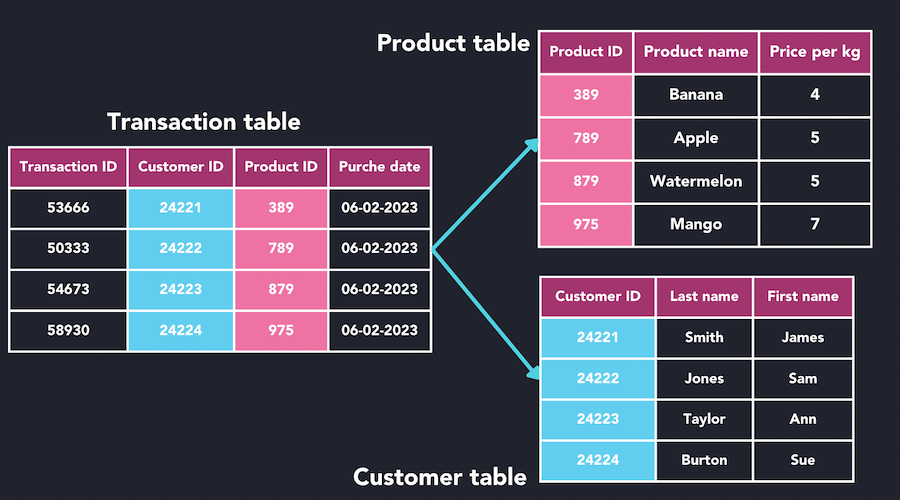A relational database is a type of database that stores and manages data in a tabular format, using a relational model. Data is organized into a collection of tables consisting of rows and columns. Each data point in a relational database is written to a row with a unique ID (key) with other attributes corresponding to each column. Data is then retrieved via Structured Query Language (SQL), which is why relational databases are often called SQL databases.

Relational databases are commonly used for scenarios where data can be logically mapped to the relational model. Because data is stored in a structured manner, relational databases can perform complex queries across tables efficiently. Finally, due to their transactional guarantees, relational databases are a great choice where data consistency and transactionality are of utmost importance such as in e-commerce or banking.
Relational model
The relational database model was first developed by Edgar F. Codd from IBM in the 1970s. In this model, data is represented by related logical tables linked through attribute relationships. For example, to represent a user’s bank account information, we may have a Transactions table and an Accounts table.
The transactions table may hold information about each deposit and withdrawal such as the source, destination, and amount. Then in the accounts table, we may have information about each account such as type (e.g., checking vs. savings) and the owner. These two tables may be linked by account ID so that each bank user can easily find their transaction information per their account.
A relational model is an intuitive way to represent data. Due to its simplicity and widespread adoption, it has been the foundation for relational database systems that are used today.
Relational model operations
Relational databases surface data via relational model operations. Some importation operations include:
- Select: Select is used to choose specific rows from a table based on a condition. It can return all the data when unspecified or filter out a subset of the rows.
- Project: Projection is used to choose specific columns from a table based on a condition.
- Join: Join operation is used to combine rows from two or more tables based on related columns.
- Union: Union combines the result of two or more select operations into a single result set.
Characteristics of relational databases
In relational databases, data is typically stored and accessed in a row format. In order to avoid full scans when selecting data, relational databases utilize indexes to quickly find the relevant rows to return.
Also, relational databases are often marked by their ACID properties. These properties are:
- Atomicity: Atomicity guarantees that all operations in a transaction either succeed or fail. If any part of an atomic transaction fails, then the entire transaction is rolled back. Think of a classic banking situation where you want to guarantee that when you pay someone, the amount being withdrawn is only debited when the recipient successfully can access that amount.
- Consistency: Consistency ensures that the database remains in a consistent, valid state after each transaction. This means that transactions should not violate any constraints, triggers, or other rules of the database. Going back to the banking example, if you have spending limits or overdraft protections set, any attempts to cross those limits should fail.
- Isolation: Isolation guarantees that transactions executed concurrently should produce an end state as if the transactions were executed sequentially. If a user had 10 at the same time, the remaining balance should read 90 as the balance.
- Durability: Durability means that once a transaction is committed, those changes become permanent. For our banking example, an ATM should return the same balance even after a power outage.
Relational databases vs. non-relational databases
The table below compares the traits of relational and non-relational databases:
| Relational Databases | Non-relational Databases | |
|---|---|---|
| Data Model | Relational | Key-value, document, graph, search, time series |
| Query Language | SQL | Varies, including SQL |
| Use Cases | Structured data, complex querying | Unstructured or semi-structured data, high write-throughput |
| Data Consistency | Strong consistency (ACID) | Eventual consistency |
| Examples | MySQL, PostgreSQL, SQL Server | MongoDB, Cassandra, Redis, DynamoDB |
Popular relational databases
Additional resources
Migrating from Relational Databases to Time series Databases